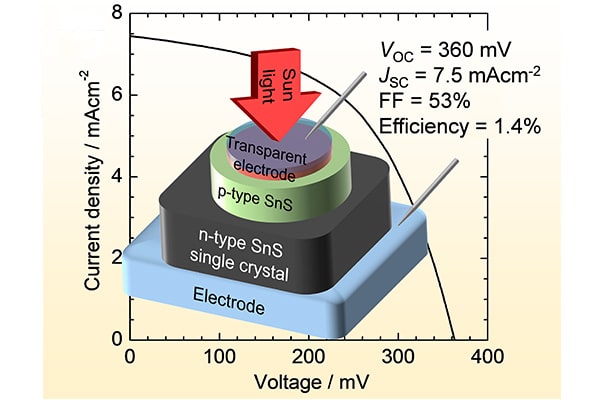Tin(II) sulfide (SnS) has emerged in recent years as a promising semiconductor material for solar cells. It is abundant in nature, non-toxic, and can be supplied at a low cost. Furthermore, it has a near-optimal direct bandgap of about 1.3 eV, a high level of environmental and chemical stability, and a high absorbance coefficient.
Although the efficiency of solar cells built with this technology lags behind other established thin-film solar materials, such as cadmium telluride (CdTe) or copper, indium, gallium selenide (CIGS), tin sulfide can potentially be produced at such a low cost that their application on small devices or in building-integrated PV should be a possibility.
With this in mind, a group of scientists from Japan's Tohoku University has built an SnS single-junction solar cell. Despite the low conversion efficiency of 1.4%, the group claims its approach brings with it the potential to push SnS solar cells beyond the highest efficiencies achieved so far, which stand at 4-5%.
The device developed by the Japanese group was fabricated with a special p-type film of the compound. “P-type SnS is easy to fabricate, but the same cannot be said of n-type SnS,” it explained. “The complexity of fabricating n-type SnS has stalled the manufacturing of the p-n homojunction for SnS solar cells.”
Popular content
The researchers built the device with p‐type thin films consisting of columnar grains and large n-type SnS single crystals. The interface of the p-n single junctions was designed to be void‐free and compositionally sharp. “The large crystals were grown using an original technique released in August 2020,” they said. The process consists of facilitating the growth of crystals measuring up to 24mm in diameter. Crystals of this size are necessary to form a junction with the much easier to fabricate p-type equivalent.
The solar cell showed a conversion efficiency of 1.4% and an open‐circuit voltage (VOC) of 360 mV, which the scientists described as the highest VOC value ever reached for SnS‐based heterojunction solar cells. “This is remarkable since this is only our first prototype,” said researcher Sakiko Kawanishi, adding that the result was achieved with no device optimization.
The solar cell is presented in the paper SnS Homojunction Solar Cell with n‐Type Single Crystal and p‐Type Thin Film, published in RRL Solar. The group also measured the cell's fill factor (FF) at 53% and a short-circuit current (JSC) of 7.5 mA cm−2.
This content is protected by copyright and may not be reused. If you want to cooperate with us and would like to reuse some of our content, please contact: editors@pv-magazine.com.



4 comments
By submitting this form you agree to pv magazine using your data for the purposes of publishing your comment.
Your personal data will only be disclosed or otherwise transmitted to third parties for the purposes of spam filtering or if this is necessary for technical maintenance of the website. Any other transfer to third parties will not take place unless this is justified on the basis of applicable data protection regulations or if pv magazine is legally obliged to do so.
You may revoke this consent at any time with effect for the future, in which case your personal data will be deleted immediately. Otherwise, your data will be deleted if pv magazine has processed your request or the purpose of data storage is fulfilled.
Further information on data privacy can be found in our Data Protection Policy.